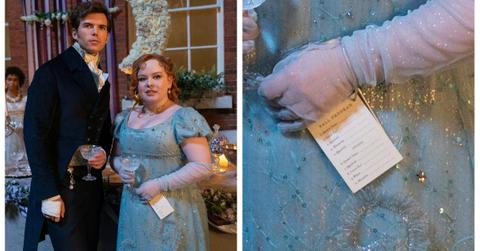The 'Bridgerton' Ladies Are Always Wearing Wrist Tags at the Balls — Is It Regency Era GPS?
The phrases "my dance card is full" and "I'll pencil you in" were both born from these funny little wrist tags.
Published May 15 2024, 6:56 p.m. ET

As we look back on the horny success of Netflix's Bridgerton, it's easy to focus on the numerous longing glances exchanged between various members of the ton. Obviously nothing could ever compare to the Duke and Daphne from Season 1, but Season 2 wasn't far behind (this is a pun). Not that anyone needs reminding, but remember that time Anthony Bridgerton fell into a lake and thus emerged like a young Colin Firth in Pride and Prejudice? It's the only wet T-shirt contest we want to watch.
Clearly we can't subsist on sassiness alone, so the production designers have gifted fans with a veritable feast for the senses. There are incredible architectural feats decorated with the opulence of that time in mind, dwarfed only by the breathtaking costumes of the individuals lucky enough to move through this world. Some of the best scenes, visually and emotionally, occur at some sort of ball. Speaking of which, what is the deal with the tags on the wrists of the Bridgerton babes at these events?

Nicola Coughlan as Penelope Featheringon; Claudia Jessie as Eloise Bridgerton; and Jessica Madsen as Cressida Cowper
Thankfully the tabs on the wrists of 'Bridgerton' ladies isn't some kind of Lojack.
It's fun to think about modern times versus the past, in terms of how things were handled during the Regency era. For example, when picturing that time, don't you feel terribly uncomfortable when considering the clothing options? The shoes were undoubtedly terrible but that's not actually the case. Women were wearing leather boots, satin slippers, and even flats. Don't flats feel like something we just started doing? But that's not true!
Things were definitely more formal when it came to communication between the upper class. Let's say you popped by a friend's house but they weren't home — you would leave a calling card. There wasn't much to it, just a little slip of paper with your name and address on it, but that's the 1800s version of leaving a voicemail. Speaking of cards, dance cards were all the rage at fancy balls. What was that about?
You don't need to look closely to spot the tags on the wrists of the wealthy women of Bridgerton. If you zoom in, you'll see that it's a tiny program featuring a list of all the songs which will be performed that evening. Next to each is a space to write something. This is a playlist of sorts and the blank section is for the dance partner of your choosing. A man can schedule a time to dance during a particular song, hence the phrase one's "dance card is full." That means you're busy so, next!
How does a dance card work exactly?
According to Kovels Antique Trader, a dance card was "typically sized to fit comfortably in a woman’s palm and would have a cover indicating the sponsoring organization of the ball and a decorative cord that could be attached to a wrist or ball gown." Occasionally a small pencil was attached to the cord but it was assumed the men would have their own pencil as it was their responsibility to do the asking. It's kind of like a condom in that respect. Women might be carrying one, but it's really on the men to take care of that.
As far as doing the actual asking, that's a bit of a dance in and of itself. The gentlemen have to stand a respectable distance from the lady in question then bow before approaching her. He then asks for a dance and never participates in more than four in a row with one woman. That's extremely bad taste.
Speaking of embarrassing behavior, the men are expected to be well-versed in the required dance moves lest they embarrass their partners. Unfortunately the women were not permitted to turn a dance request down unless they were already spoken for, for that dance. Dance cards were still fashionable through the 1920s and into the 1930s before fading away in time for Jazz Age. But here's a fun fact: The phrase "pencil you in" was born from the dance card! It's funny what we hold onto, and what we let go.